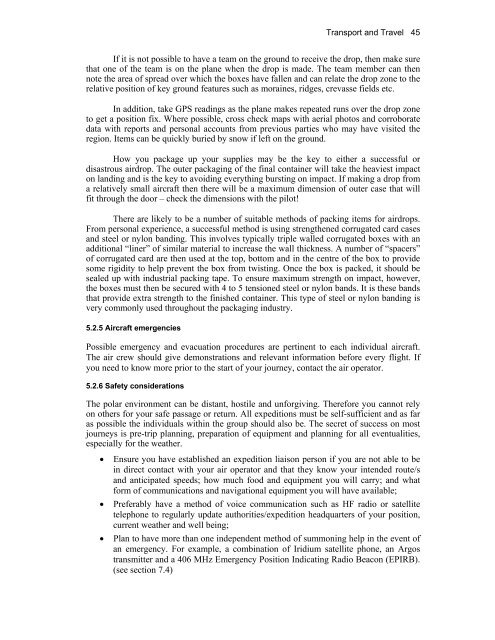Edited by Rachel Duncan 4th Edition ISBN 0-907649-91-2 London ...
Edited by Rachel Duncan 4th Edition ISBN 0-907649-91-2 London ...
Edited by Rachel Duncan 4th Edition ISBN 0-907649-91-2 London ...
You also want an ePaper? Increase the reach of your titles
YUMPU automatically turns print PDFs into web optimized ePapers that Google loves.
Transport and Travel 45<br />
If it is not possible to have a team on the ground to receive the drop, then make sure<br />
that one of the team is on the plane when the drop is made. The team member can then<br />
note the area of spread over which the boxes have fallen and can relate the drop zone to the<br />
relative position of key ground features such as moraines, ridges, crevasse fields etc.<br />
In addition, take GPS readings as the plane makes repeated runs over the drop zone<br />
to get a position fix. Where possible, cross check maps with aerial photos and corroborate<br />
data with reports and personal accounts from previous parties who may have visited the<br />
region. Items can be quickly buried <strong>by</strong> snow if left on the ground.<br />
How you package up your supplies may be the key to either a successful or<br />
disastrous airdrop. The outer packaging of the final container will take the heaviest impact<br />
on landing and is the key to avoiding everything bursting on impact. If making a drop from<br />
a relatively small aircraft then there will be a maximum dimension of outer case that will<br />
fit through the door – check the dimensions with the pilot!<br />
There are likely to be a number of suitable methods of packing items for airdrops.<br />
From personal experience, a successful method is using strengthened corrugated card cases<br />
and steel or nylon banding. This involves typically triple walled corrugated boxes with an<br />
additional “liner” of similar material to increase the wall thickness. A number of “spacers”<br />
of corrugated card are then used at the top, bottom and in the centre of the box to provide<br />
some rigidity to help prevent the box from twisting. Once the box is packed, it should be<br />
sealed up with industrial packing tape. To ensure maximum strength on impact, however,<br />
the boxes must then be secured with 4 to 5 tensioned steel or nylon bands. It is these bands<br />
that provide extra strength to the finished container. This type of steel or nylon banding is<br />
very commonly used throughout the packaging industry.<br />
5.2.5 Aircraft emergencies<br />
Possible emergency and evacuation procedures are pertinent to each individual aircraft.<br />
The air crew should give demonstrations and relevant information before every flight. If<br />
you need to know more prior to the start of your journey, contact the air operator.<br />
5.2.6 Safety considerations<br />
The polar environment can be distant, hostile and unforgiving. Therefore you cannot rely<br />
on others for your safe passage or return. All expeditions must be self-sufficient and as far<br />
as possible the individuals within the group should also be. The secret of success on most<br />
journeys is pre-trip planning, preparation of equipment and planning for all eventualities,<br />
especially for the weather.<br />
• Ensure you have established an expedition liaison person if you are not able to be<br />
in direct contact with your air operator and that they know your intended route/s<br />
and anticipated speeds; how much food and equipment you will carry; and what<br />
form of communications and navigational equipment you will have available;<br />
• Preferably have a method of voice communication such as HF radio or satellite<br />
telephone to regularly update authorities/expedition headquarters of your position,<br />
current weather and well being;<br />
• Plan to have more than one independent method of summoning help in the event of<br />
an emergency. For example, a combination of Iridium satellite phone, an Argos<br />
transmitter and a 406 MHz Emergency Position Indicating Radio Beacon (EPIRB).<br />
(see section 7.4)

















